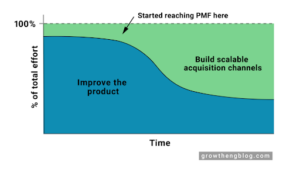Comprehensive and reliable data is imperative to making sound business decisions that improve performance and increase profitability for direct-to-consumer (DTC) brands — and not just at the C-suite level. Every department, from marketing to people operations, would function more effectively if they were equipped to make data-driven decisions.

DTC brands are at an advantage when it comes to data accessibility, as they aren’t reliant on retailers or other middlemen for buyer behavior insights or purchase activity data. Even so, internal blockers like siloed data or technology limitations stand as the biggest hindrances to gathering and sharing data across teams. Devising a data strategy and implementing a modern data stack to support it would alleviate these obstacles and help make brands future-ready.
Characteristics of a future-ready business
The pandemic showed us just what it takes for a business to be future-ready. Some companies were slowed by inflexible operations, while others quickly pivoted to meet demand in new ways. Key characteristics of organizations that were most successful include:
- High level of employee autonomy to support agility.
- Adaptability in mindset and operations.
- Tech-inclined and open to new solutions.
- Applies a cross-functional data strategy.
The common thread among these characteristics is data. Here’s a snapshot of its impact:
- High level of employee autonomy to support agility. Employees can only feel empowered to make quick, informed decisions if they have data that enables them to work through the decision-making process.
- Adaptability in mindset and operations. Having the willingness to adapt is one thing, but when it comes down to it, the actual ability to adapt is critical. There is always risk involved in change, so it’s important to test and learn in order to determine the optimal path forward. Data is vital in making this calculation.
- Tech-inclined and open to new solutions. When you’re building a modern data stack, you must think critically about how the systems are integrated so that performance is optimized and all relevant data is made available to stakeholders. From there, it’s important to trust the insights you can generate and find ways to make them actionable for your specific business.
- Applies a cross-functional data strategy. Equipping all teams with analysis-ready data is imperative, but departments must also have a strategy to share their insights more broadly. This approach maintains transparency, enables better collaboration, and gives stakeholders complete information to support decision-making.
The most successful businesses have a cross-functional data strategy — that enables them to collect, organize, utilize, and share data — to achieve agility, adaptability, and well-equipped, data-driven teams.
What to invest in now to prepare for the future
A data strategy goes hand-in-hand with your organization’s particular tech stack. It’s important to view the data stack holistically and not by team. Each department utilizes one or more discrete platforms that are tailored to its core functions — for example, marketing alone may use separate tools for SEO, email, social media, ad management, and more. The way data gets siloed is when teams only use their platform’s native reporting and analysis tools to make important decisions. Seeing just the revenue results from a new product launch, for example, won’t tell you how different marketing channels performed in driving consumers to your new product, let alone reveal a spike in customer service touchpoints.
A critical part of your data strategy is establishing a single source of truth to break down silos and integrate data from these different sources. This is why you need to invest in a data warehouse. You can extract raw data from individual platforms, and then store, clean, and organize the data in your warehouse so it can be exported to a business intelligence (BI) tool. From there, stakeholders can access reports and dashboards that show the full picture based on reliable data.
Extraction can be performed on-demand or on a scheduled basis to refresh the warehouse and your BI tool with updated data. The cadence should be decided as part of your data strategy, so you always have the data you need, but also aren’t wasting resources refreshing your data more frequently than necessary. When you think about extracting data, you should also consider details like your personally identifiable information (PII) policy, so PII can be excluded when necessary to ensure you’re protecting your customer’s privacy and are legally compliant.
Why a BI tool must be part of your data strategy
We spoke with Margaret Fortner, Head of Growth at Glamnetic, a DTC brand in the beauty category, to understand the infrastructure, strategies, and best practices their organization uses to be data-driven. She identified a BI tool as being critical to their decision-making process and provided examples of the way it’s used internally.
One of the unspoken benefits of a BI tool, she said, is that it is accessible for stakeholders who have differing levels of comfort with data manipulation and visualization. You can create dashboards with different charts and tables for each person, depending on what information they need to review regularly. Additionally, you don’t need to worry that less technically adept users will edit, overwrite, or delete data, as it’s already been extracted from each platform and does not sync bidirectionally.
Those who have the technical competency to leverage advanced BI features can get more granular with the available data. Fortner, for example, regularly reviews customer cohorts to understand their behavior and the team’s acquisition tactics, and in turn informs Glamnetic’s retention strategy.
She notes that it’s typical for teams at other companies to cohort just by acquisition month, but stopping there prevents you from gaining deeper insights. Fortner recommends slicing and dicing in as many ways as possible: by products purchased, discount code, marketing platform, etc. “We’ve set up our data systems to support that,” she notes. “We’re constantly tracking all development retention rate metrics over time.”
Fortner pairs retention data with the cohorts to make acquisition decisions. One insight she came across stands out as particularly useful example: “I saw a platform that had, as an example, a less efficient customer acquisition cost than another platform. And we were kind of like, all right, should we be continuing to invest in this? Should we not? And then I looked at our retention rate and I saw that our retention rate on that platform was significantly higher than our average, and especially versus the platform that we were going to push that money into. So I made the decision…it’s going to make sense to continue to invest in this platform, even if from a first-purchase standpoint it doesn’t look like it’s going to be as good.”
Tips for planning a data strategy
Future-ready businesses need to be forward-thinking. Fortner offers a few key pieces of advice for how to get there.
First, build your team to be data-driven from the start. “I love to hire people who are quantitatively-driven first and marketers second,” she said. “A lot of times we ask for people who have [quantitative] backgrounds or with quantitative majors, if they’re coming out of college.”
Second, capture data as early as you can and be consistent in how you label and organize information, so everything is uniform and can be adapted to your specific needs. For example, as a marketer, creating a strategy around naming conventions and using it from day one is critical. Without consistent naming conventions, it’s time-consuming at best and impossible at worst to organize rows of inconsistent data. “Any information you’re capturing earlier, you can make better decisions with it because that can lead to quicker aggregation over time,” Fortner advises. “Have a comprehensive naming convention [from the start] that allows you to see what’s really working and slice and dice across ads.”
Third, spend the time to create the right dashboards for your team in your BI tool “to show you what you need to see quickly, accurately, efficiently, flexibly,” Fortner says. “I think being able to adjust the date range for things is kind of an underrated differentiator that you have when you’re using data visualization tools versus just pulling into Excel.”
The final piece of advice Fortner offers when it comes to leveraging business data is to use the framework of “the what, the why, and the what’s next?” This, she says, is the difference between being a “level one” data-driven employee and a “level three”. As an example, in the context of DTC marketing, your what may be that your CPA went up by 40% week over week. You’ll dig into your data to determine the why. Then, based on your findings, you’ll decide what to do next.
“If you really want to be successful, it’s about taking those next steps, and I think it becomes easier to make those subsequent steps if you set yourself up well from a data platform standpoint,” she says.
Building a modern data stack
It’s impossible to predict how DTC or demand will change in the future, but building an integrated data stack and implementing a complementary data strategy are the foundation for success. With almost six in 10 Americans having made at least one purchase from a DTC brand in 2021, the space has plenty of room for growth, which means there will be more data to collect and use for decision-making.
Setting up your organization for success starts with putting the right tools in place. Mozart Data’s modern data platform uses a data warehouse to clean, transform, and organize disparate data sets so you can sync reliable information to the BI tool of your choice. If you’re struggling to build out a data strategy or don’t know how to answer certain technical questions, our in-house data analysts are here to help. Get the support your business needs by scheduling a demo with the Mozart Data team.


